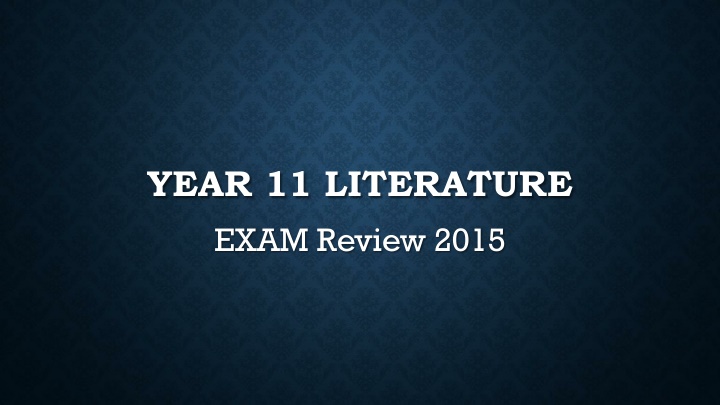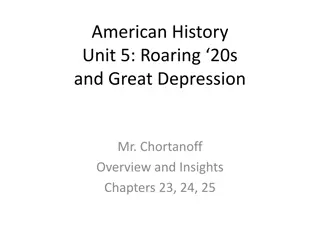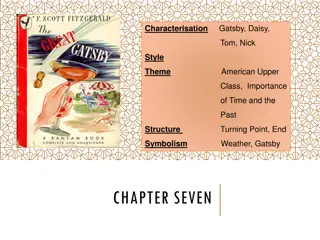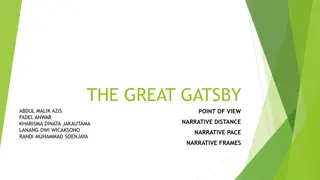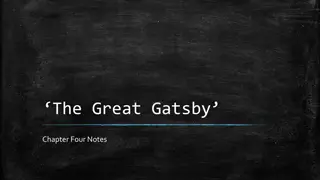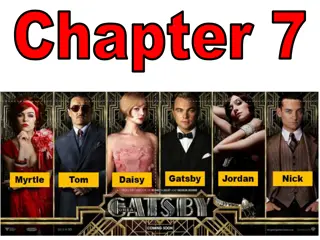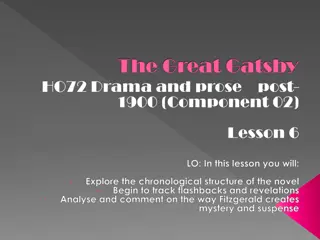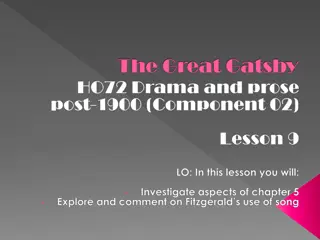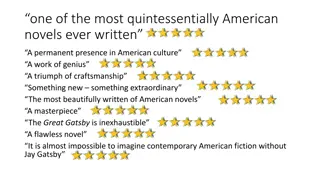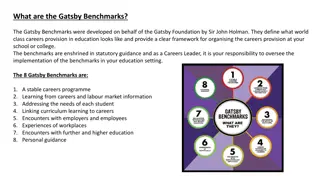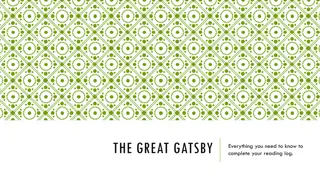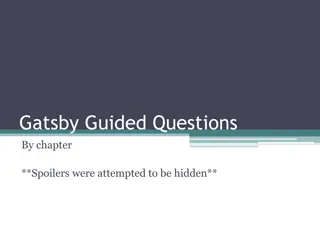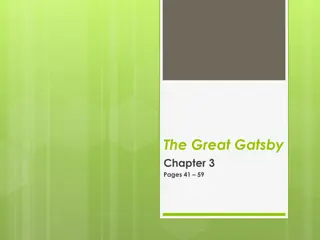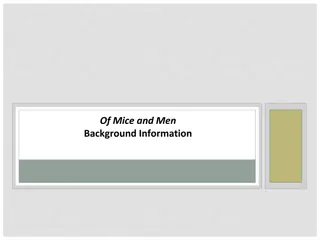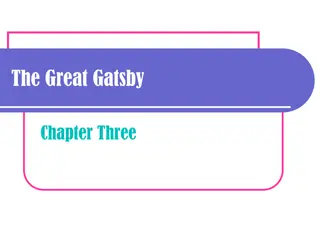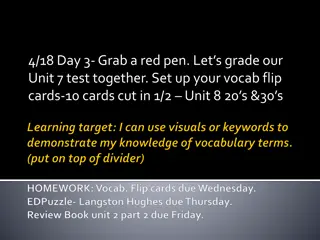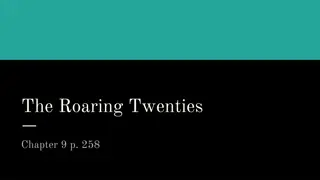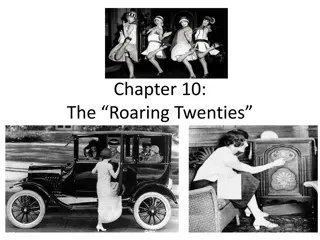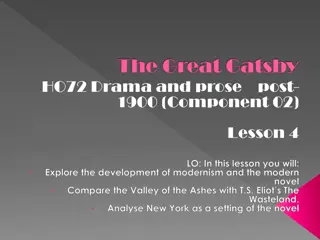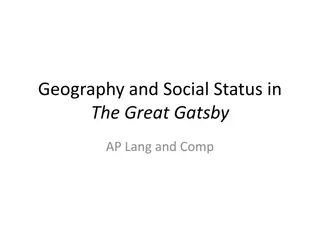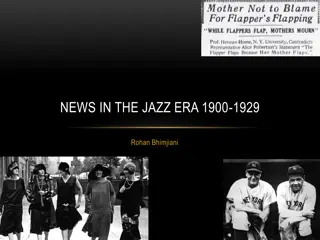The Great Gatsby: A Reflection of American Culture in the Roaring Twenties
The Great Gatsby, a timeless piece of literature, showcases various aspects of American culture during the roaring twenties. It delves into the pursuit of the American dream, the romanticism of the era, relevance of its ideas even today, and the destructive power of obsession. Through intricate prose and compelling characters, the novel explores themes of love, wealth, and societal expectations, making it a must-read for those interested in a vivid portrayal of a bygone era.
Download Presentation

Please find below an Image/Link to download the presentation.
The content on the website is provided AS IS for your information and personal use only. It may not be sold, licensed, or shared on other websites without obtaining consent from the author.If you encounter any issues during the download, it is possible that the publisher has removed the file from their server.
You are allowed to download the files provided on this website for personal or commercial use, subject to the condition that they are used lawfully. All files are the property of their respective owners.
The content on the website is provided AS IS for your information and personal use only. It may not be sold, licensed, or shared on other websites without obtaining consent from the author.
E N D
Presentation Transcript
YEAR 11 LITERATURE EXAM Review 2015
THE GREAT GATSBY Reasons it is important as a piece of Literature: 1) Reflects American Culture 2) Reflects the romance of the roaring twenties 3) Ideas are still relevant 4) Reflects obsessive psyche of modern society crazy love 5) Flawless and imperishable prose the language is highly detailed, figurative and captures the pain and beauty of people, while philosophising about life
THE GREAT GATSBY 1) Reflects American Culture: "It is the story that if you work hard enough, you can succeed. The Great Gatsby is a national scripture. It embodies the American spirit, the American will to reinvent oneself." It is no coincidence that The Great Gatsby is probably the American novel most often taught in the rest of the world. "It is our novel, how we present ourselves. ... He captured and distilled the essence of the American spirit." Yet Gatsby also explores the dream's destructive power. "Americans pay a great price for that dream" The Great Gatsby also captures money's power to corrupt, to let the rich escape from the consequences of their actions. Here's Fitzgerald's description of that original 1% couple: "They were careless people Tom and Daisy they smashed up things and creatures and then retreated back into their money "
THE GREAT GATSBY 2) Reflects the romance of the roaring twenties Fitzgerald was the poet laureate of what he named "The Jazz Age," the most raucous, gaudy era in U.S. history. "The 1920s is the most fascinating era in American culture, "Everything was changing so much." It was flappers, cars, sex, movies, gangsters, celebrities, a stock market minting money, everything awash in illegal booze. The wildest parties and bad behaviour among the rich and famous today have nothing on the you-only-live-once hedonism depicted in The Great Gatsby. The characters of Jay Gatsby and Daisy reflect an idealised concept of love that links success, money, power and exclusiveness to the notion of romance and sex. Unfortunately the concept is one of selfishness and self gratification having little concern for others, family or those who are sacrificed along the way.
THE GREAT GATSBY 3) Ideas are still relevant "it never seems to lose its modernity; it has that kind of staying power One reason: It offers complicated characters who can be interpreted in fresh ways for new readers. Is Nick in love with Gatsby? Could Gatsby the other, the outsider actually be a black man? Often dismissed as a selfish ditz, is Daisy victimized by a society that offers her no career path except marriage to big bucks? "It is one of those novels that is talked about nearly 100 years later for a reason," says DiCaprio who first read Gatsby when he was 15. "It's incredibly nuanced and it's existential and at the centre of this movie is this man who is incredibly hollow. The dream of Capitalism is alive in this film modern Westernized society (and many other cultures) still equate success and opportunity with wealth and power.
THE GREAT GATSBY 4) Reflects obsessive psyche of modern society crazy love What makes Gatsby magical is his motivation. Although he's made his fortune as a bootlegger and gambler, greed doesn't drive him. Rather he's on a quest to reclaim Daisy. It's about a narcissistic obsession with the past. To Gatsby, Daisy isn't a married woman with a daughter. She's an object, something he lost and wants back. Which makes his actions such as buying a mansion across the water from the Buchanans so he can stare at the green light at the end of their dock well, kind of creepy and stalker-like. He is almost like the corporate sociopath who focuses on winning at any cost, who refuses to see reality and will live in a false, artificial world, living by false values she has to tell him she never loved him
THE GREAT GATSBY 5) Flawless and imperishable prose the language is highly detailed, figurative and captures the pain and beauty of people, while philosophising about life "Fitzgerald had a pitch-perfect ear," - "There's not one flabby sentence," (Nilsson) For evocative beauty, what can ever beat the last line of The Great Gatsby, which is engraved on the Rockville, Md., grave the author and his wife Zelda share. "So we beat on, boats against the current, borne back ceaselessly into the past.
LITERARY DEVICES Foreshadowing The act of presenting materials that hint at events that occur later in a story. All the way leading up to the climax, Fitzgerald hints at the downfall of Gatsby, such as in Chapter 3 where he writes, He snatched the book from me and placed it hastily on its shelf muttering that if one brick was removed the whole library was liable to collapse. Irony The difference between appearance and reality. There are three types: 1) Dramatic Something is known by the reader but not by the characters. Characteristic of this is the scene where all the characters except Tom are aware of the affair between Gatsby and Daisy, until of course it finally hits him. 2) Verbal A statement that was made that implies the opposite. Used extensively by Fitzgerald, it was many times in reference to Gatsby, like when Wolfshiem says that Gatsby would never so much as look at a friend s wife. 3) Situational An event happens that is contrary to the expectations of the reader. At the very end of the story, contrary to the expectations, or at least the hopes, of the readers, Fitzgerald has Daisy stay with Tom instead of leaving him. Allusion a reference to a person, event, object, or work from literature that is expected to be known by the reader. There are numerous references throughout the entire work to literature.
LITERARY DEVICES Symbolism presenting a thing that represents both itself and something else. Fitzgerald made many things in The Great Gatsby highly symbolic to try and better convey his themes. Among others, he uses colors, locations, seasons, cars, and Daisy s voice. Aphorism- An aphorism is a short saying or pointed statement. Examples of aphorisms include Time is money or The early bird catches the worm. An aphorism that gains currency from generation to generation is called an adage or proverb. An example of an aphorism occurs early in the book when Nick Carraway narrates for us the wise advice his father had given him, Whenever you feel like criticizing anyone, just remember that all the people in this world haven t had the advantages you ve had. Flashback- A flashback is a section of a literary work that presents an event or series of events that occurred earlier than the current time in the work. Writers use flashbacks for many purposes, but most notably to provide background information, or exposition. An example of a flashback occurs in chapter 4, starting when Jordan says One October day in nineteen-seventeen. Simile- A simile is a comparison of two things using the word like or the word as . Similes occur very regularly throughout the book. Some examples include at the start of chapter 3, where Nick narrates to us, In his blue garden men and girls came and went like moths among the whisperings and the champagne and the stars. Another one occurs in chapter 7, when Nick says, Daisy and Jordan lay upon an enormous couch, like silver idols, weighing down their own white dresses against the singing breeze of the fans . These occur rather regularly throughout the book. Metaphor- A metaphor is an indirect comparison of two things without the use of the words like or as . Daisy uses a metaphor to describe Nick in chapter 1 when she says, You remind me of a- of a rose, an absolute rose. Doesn t he?
PASSAGE 1 BEGINNING OF CHAPTER 2 Fitzgerald actually saw this 'valley of ashes. Consider the previous chapter, specifically the descriptions of Tom and Daisy's and Gatsby's mansions and vast gardens. Here, the ashes grow into 'hills and grotesque gardens' and 'take the forms of houses.' We can interpret this as a premonition from Nick - a strong feeling (Foreshadowing) that something unpleasant is about to happen. This valley of ashes is not far from the luxurious houses of East Egg. Perhaps he senses that soon they will figuratively disintegrate into ash. Nick is taking the train into New York City with Tom Buchanan. It is an area where ashes from coal burning furnaces are deposited. Everything is gray and lifeless, even the people who work and live in the area. Nick describes an old billboard for an optometrist, Doctor T.J. Eckleburg. billboard features a pair of giant eyes (Metaphor) that seem to be gazing down on the people below. This billboard is an important feature of the novel (Recurring motif) , and is intended to suggest that God is watching this area. Symbolizing the loss of faith from American society as they replace religion and values with those of consumerism, capitalism and the American Dream. Juxtaposition of the wealthy (in their egg like bubble), the wasteland that lies between (the discarded, used refuse) and the city (symbolizing progress and population growth, post WW2)
PASSAGE 2 CHAPTER 3 Reflection of 1920s city and economic boom Increasing sense of loneliness and disconnection in society Both Nick and Jordan are lonely, isolated figures Jordan is a flawed character - Alluding to the underlying carelessness which is present to almost every character in Gatsby, Jordan is careless to her belongings and affiliates because she is so polp-pony rich. She is not evil or malevolent, but she is just careless, they smash up things and then retreat into their carelessness. She doesn t mind lying to get her way Gatsby is littered with allusions to The Waste Land, and the closing sentence of this paragraph recalls T.S. Eliot s depressing description of wage labor. The throbbing taxi-cabs is most definitely an allusion to At the violet hour, when the eyes and back Turn upward from the desk, when the human engine waits Like a taxi throbbing waiting I Tiresias, though blind, throbbing between two lives Jordan purposely avoided clever and sharp men throughout her life, fearing that they would reveal to her what she actually was, in contrast with her own idealistic view of herself.
PASSAGE 3 CHAPTER 7 Wilson tries to keep talking about the man that he suspects his wife is cheating on. For obvious reasons, Tom tries to end this conversation and drive away. But now it is clear to everyone that George knows something is going on with Myrtle and will take action to prevent it. Earlier in the day, Tom also wised up to the fact that Daisy and Gatsby are having an affair. Nick is confused because he sees how differently Tom and George Wilson s reactions are. George is devastated, while Tom seems indifferent. The parallel situations really tells the reader a lot about the two characters. Over the course of the novel the eyes of Doctor T.J. Eckleburg become a symbol for, among other things, the eyes of God, watching over mankind. The fact that it s an ad, though, implies that this God may be illusory, corrupt, or ridiculous. I ll let you have that car - symbolic of saying that his affair with Myrtle is now over. Symbolic cars colours and object of destruction Foreshadowing - the car that Myrtle sees is Gatsby s yellow one (Fool s gold), not Tom s usual blue (High social status) coupe. Myrtle will assume that Tom is driving this car in the future, which will become hugely important. The self absorption of characters in the novel is so clear here. Myrtle is engrossed meaning that she focuses single-mindedly on the fact that Tom is with another woman, who she blindly assumes to be his wife. If there is one thing made clear about Tom in this novel, it is that he loves and needs control. This becomes clear through the way he drags Nick around the city to his domestic abuse towards Daisy and Myrtle. And right now he has no control, since his wife is speeding away with another man, and his mistress is leaving town soon. The word spidery creates a sense that the beams holding up these homes are weak. This could be a metaphor for the weak foundations that propel the rich. We know that the Wall Street Crash happened shortly after The Great Gatsby was published, did Fitzgerald see it coming? This is Tom s car, which Gatsby is driving. Tom finally caught up to them and is feeling a little better now that he doesn t have to physically chase down Daisy anymore. He knows Gatsby cannot fill his shoes .
PASSAGE 4 CHAPTER 6 The symbolism of the moonlight in this chapter is two fold. - On one hand, it represents Daisy s fleeting innocence and purity that she still has. When we first see Daisy, she is wearing a white dress, but now that innocence and purity has been reduced to this thin layer of moonlight, which is easily broken. - On the other hand, the thin ray is symbolic of the opportunity for Gatsby to reach and chase his dreams. Towards the beginning of his life the night is filled with moonlight, but as it progresses and he gets older, doors close, and there is no way to undo the closing. I like her - Daisy has no real basis on which to like the starlet other than her appearance. This comment sums up the values of Daisy and her careless, shallow companions. Society has judged Daisy all her life for her beauty, and she has come to accept and employ this herself. Links to beautiful little fool . Daisy, as a member of the aristocracy, is very used to living with gestures , as throughout the book Nick heavily emphasizes how the upper class hides under a facade of propriety. These manners are fake and lack warmth. She is offended by raw emotion, she is not conditioned that way. Fitzgerald uses the shadows as representations of the immorality and dehumanization of the upper class, in an attempt to connote the lack of empathy of the superior class. The indefinite procession of shadows suggests that gaining wealth does not make one stand out, as was the common belief, but that it simply clumped those who were trying to attain the American Dream through wealth into a group of shadows. This contemptuous question displays Tom s sense of superiority as a member of an established East Egg family. Old money looking down on new money.
PASSAGE 4 CHAPTER 6 On the other hand, there are the emotions that Daisy deplores. Emotions are raw, irrational, and real, and they are representative of the struggle for self-improvement associated with new wealth and the American Dream. She is offended because she is accustomed to her one-dimensional, casual life of the upper class, and the stark contrast between that and the vitality of the party scene disgusts her, so she looks down on the crowd full of emotion in contempt. This line describes Daisy s prejudices against new wealth and that culture, especially Broadway and the culture of rich people that come from there. The 1920 s was when Broadway first started to become a popular form of entertainment, as a result of the popularity and influence of Vaudeville. Broadway created a culture of celebrity obsession because Broadway shows in the 20 s emphasized the celebrities in them rather than the content. Daisy sees the American Dream as a hopeless endeavor. In her opinion, even if a person can rise from nothing (poverty), without a title, he or she still has nothing. There is no rags to riches story because without argument, no one from the lower class can work their way into creating a history, nobility, and a true name for himself. This obtrusive fate forced upon those in the lower class is maintained by people who are part of the exclusive club that is old wealth. They do not accept new members, regardless of economic standing. Tom frequently uses language to degrade the things that other people admire about Gatsby. By calling his house party a menagerie, he makes it sound disordered and ridiculous, and not in a good way. Similarly, Tom looks down on Gatsby s yellow car as a circus wagon ; in spite of the wealth it took Gatsby to acquire this lifestyle, Tom knows he is new money and so refuses to be impressed by his achievements.
PASSAGE 5 CHAPTER 7 This is different than saying I never loved him. Daisy is confused because it makes no sense for her to love a man who cheats on her and possibly beats her, but somehow she still loves him. This scene parallels the party moment when Myrtle is asked if she loved Mr Wilson. Myrtle has no problem selling out Wilson to show off for Tom, but Daisy can t bring herself to do the same to be with Gatsby. Gatsby s absurd expectations for Daisy are starting to drive her farther away. He should know that Daisy hates making the tough decisions, and he is forcing her into making the most extreme one of her life. If he was just content with just letting her choose between him and Tom, she would probably choose Gatsby since it seems like she has more actual love for him. But for her to choose Gatsby and denounce Tom is that much harder. Daisy s love for both Gatsby and Tom has caused irreplaceable damage. These are empty words here. She is choosing Gatsby, but is unwilling to give in to all of his demands. She says these words to make Gatsby happy, but she knows she loved Tom at some points. Kapiolani - Spending time leisurely is a behaviour associated with conspicuous consumption. Many times, only the wealthy have the opportunity to take extravagant vacations. While Tom is demonstrating all the memories they have together, he is still defining his marriage with Daisy in economic and material terms instead of expressing emotional love. At this climatic moment of conflict between the married couple Tom and Daisy Fitzgerald describes the celebrations of marriage below as muffled and suffocating.
PASSAGE 5 CHAPTER 7 Daisy chooses Gatsby over Tom for the time being. But if this relationship were to continue it would be based on a lie that she was forced into. She is still unwilling to admit that she never loved Tom because she know it isn t true even if she married him for his money she knows she grew to love him after the marriage. Then she addresses Gatsby in a cold and defiant voice, indicating she is not happy at all with what he just made her do. Symbolism - Daisy very nearly ignites a fire, foreshadowing that she is about to cause the eruption of the mounting tensions between the characters. reality doesn t match up to the expectation, since Daisy doesn t care about the past, and her reasons for choosing him would be different than what he hoped for. Gatsby wants the reason she chooses him to be that she wants to go back to the way things were, but she is really doing it because she thought it would be better for her going forward. Daisy has become a symbol of happiness and love for him. He could not bear the notion that who he considers to be his divine and only love has affection for someone else. This realization nearly destroys his conception of love for the past five years as he murmurs almost subconsciously and grasps desperately to the last straw of hope by repeating the question, You loved me too? Gatsby still hasn t abandoned hope yet, that just isn t the way things work with him. He feels like Daisy is just overwhelmed by the moment and doesn t know what to decide, which is partly true. But she has also made it pretty clear that she won t say she never loved Tom because its not true. This also continues the idea that Gatsby feels like he can decide what Daisy wants for her, without even considering her opinion. Daisy s comments during the conversation almost seem to serve as an internal monologue. Daisy is conflicted about her feelings concerning Gatsby and Tom because she recognizes how her definition of love has changed over time.
PASSAGE 6 CHAPTER Symbolism - Gatsby tries to defy the passage of time and cling to the past. Even as the autumn leaves are beginning to fall, he won t let the servant clean the pool, and instead decides to go swimming as though it were still the height of summer. This becomes an especially potent symbol later on, when Wilson finds Gatsby in the pool and kills him. If Gatsby had been in the house, and not pursuing hobbies out of season, things might have gone differently; but because of Gatsby s hamartia (tragic flaw) a hopeless attachment to the past he is doomed to be in the wrong place at the wrong time. Irony and foreshadowing - This throwaway line a quip, almost is deeply ironic when the events of the rest of the chapter are considered. I suppose Daisy ll call - Even after all that s happened, Gatsby s dream has not died. He still lives in hope that Daisy will return to him despite the unlikeliness of it happening. Nick, who is inclined to reserve all judgments, finally makes a strong judgment here, calling Daisy, Tom, Jordan, and all the upper class morally rotten. He knows and feels that Gatsby is worth more than them all and tells him so. Probably no one has ever complimented Gatsby in this way before, even if he secretly agrees with Nick (see ecstatic cahoots below), which is why Gatsby breaks out into a radiant smile.
PASSAGE 6 CHAPTER It is noteworthy that Gatsby s real history, however tainted by criminal enterprise, makes him more admirable by classic moral standards than the initial impression he gives Nick. Whilst Gatsby (still) believes that coming from Old Money and travelling the world as a man of leisure will give people the best impression of him, it is his private, sentimental side his heroism in the war, his determination in the pursuit of his dreams, and his dogged devotion to the love of Daisy that forms Nick s final opinion of him here. Author s comment It was the only compliment I ever gave him Nick has spent most of his story revealing his scorn for members of the upper class like Tom, Daisy, and Jordan, so Nick saying that the one true compliment he ever gave to Gatsby was that he was worth more than members of Old Money is backhanded at best. Oxymoron pink rag of a suit, Gatsby would never have worn a rag of a suit because he cares so much about his appearance. Slightly ironic that Gatsby s incorruptible dream is based upon illegally bootlegging alcohol. Gatsby can never live out the American Dream because he is not honest and moral.
SEAMUS HEANEY Seamus Heaney is widely recognized as one of the major poets of the 20th century. A native of Northern Ireland, Heaney was raised in County Derry, and later lived for many years in Dublin. He was the author of over 20 volumes of poetry and criticism, and edited several widely used anthologies. He won the Nobel Prize for Literature in 1995 "for works of lyrical beauty and ethical depth, which exalt everyday miracles and the living past." Using descriptions of rural labourers and their tasks and contemplations of natural phenomena filtered through childhood and adulthood Heaney "makes you see, hear, smell, taste this life, which in his words is not provincial, but parochial; provincialism hints at the minor or the mediocre, but all parishes, rural or urban, are equal as communities of the human spirit,"
SEAMUS HEANEY As a poet from Northern Ireland, Heaney used his work to reflect upon the "Troubles," the often- violent political struggles that plagued the country during Heaney s young adulthood. The poet sought to weave the ongoing Irish troubles into a broader historical frame embracing the general human situation in the books Wintering Out (1973) and North (1975). The author "has written poems directly about the Troubles as well as elegies for friends and acquaintances who have died in them; he has tried to discover a historical framework in which to interpret the current unrest; and he has taken on the mantle of public spokesman, someone looked to for comment and guidance "Whatever the occasion childhood, farm life, politics and culture in Northern Ireland, other poets past and present Heaney strikes time and again at the taproot of language, examining its genetic structures, trying to discover how it has served, in all its changes, as a culture bearer, a world to contain imaginations, at once a rhetorical weapon and nutriment of spirit. He writes of these matters with rare discrimination and resourcefulness, and a winning impatience with received wisdom."
SEAMUS HEANEY Heaney s poetry has cultivated worldly, cosmopolitan views with the relics of the Northern Irish landscape, rural life, Irish history and contemporary Northern Irish politics. He has been fascinated by his culture and civilization of the past and through his poetry, Heaney has revived his past and he has kept it alive. As a poet, Heaney put great reliance on the importance of past history in understanding present events. In order to fully comprehend and find a solution for the troubles ailing Ireland, Heaney resorts to the wisdom of the past
1 - FOLLOWER He uses first person narrative to relate to us the personal relationship he is going to explore. my father gives the poem a distinctly personal appeal . The historical context and job of his father are also made clear when he tells us that he worked with a horse and plough. The fathers power then soon became clear when Heaney uses a very effective simile to capture the build and physical strength of his father recalling his shoulders globed like a full sail strung. He mentions that his father has skills working with the plough. Single pluck of reins means that he was able to motivate the horses to go back into the land again. The Visual Image allows us to clearly see how huge he was through the eyes of a young boy. I Stumbled... Key Structural Device- The Poet Uses A Shift moves from the young boy recalling his father s powerful presence and skills to focus more on his memories of himself. Negative Verb (Contrast Used) He Views Himself very negatively - the Father was viewed positively with the verb choice Sail strung Hobnailed Wake Nautical Images Used to emphasise power and then powerlessness. He can never fill his Father s shoes or follow in his footsteps. fell another negative verb which contrasts with the oxymoron used polished sod to show how powerless he felt in being able to be perfect. I stumbled in his hobnailed-wake . The poet uses a negative verb. He tells us how powerful his father was but the young boy feels inadequate. The father is viewed very positively and the young boy is viewed very negatively. The poet focuses on himself now- shift, memories of working with his father on the farm.
1 - FOLLOWER I wanted to grow up and plough this tells us that the young boy wanted to grow up like his father and plough, past vision is being used. To close one eye, and stiffen my arm, all I ever did was follow, in his broad shadow around the farm. All I ever did was follow the poet is telling us that all the young Heaney done was follow his father around the farm, assonance is being used. I was a nuisance, tripping, falling, yapping always The poet is telling us that he sees himself as powerless against the powerful father. A succession of negative verbs are being used. But today it is my father who is stumbling behind me, and will no go away. Assonance and consonance is being used. He uses very gritty, technical words (the wing, the bright steel- pointed sock, the headrig) -You almost feel that if you were to follow these instructions, you too would be able to follow in the footsteps of this father who really knew how to plough the land Father like a ship in first line, almost mythical, sailing off in front of him Metaphors- exactness of ploughing, wanting to really get it perfect Rich imagery- the sod rolled over without breaking
1 - FOLLOWER a, b, a, b rhyming pattern mirrors perfectly the action of ploughing in parallel lines Violent enjambment as we come round the headrig, which mirrors the effort in moving smoothly put into ploughing ( without breaking is a sort of forewarning that you ll have to continue with taking breath) Key subject poem deals with is inversion of relationship/ authority/ dependency between father and son another metaphor lurking under words of poem- child hounding father (where yapping comes into play), just as in some sense the father will later on come to hound the boy Ambiguity at the end- the father literally stumbling behind (an old man), or is he a memory, or is the father old and alive but the memory of the past still there and will not go Father is a god- like figure/ mythical figure in Heaney s life, poem about falling of this god Boy greatly admires his father, follows him around all the time when he s working, as they grow older the roles are reversed in their relationship; it s his father who follows him An expert. - short and blunt, helps to emphasize accuracy and determination with which father works
2 - MID-TERM BREAK Mid-Term Break was written on 25th February 1963, the 10th anniversary of the death of the poet's brother, Christopher who died on 25th February 1953. Reference 'Stepping Stones: Interviews with Seamus Heaney'. The poem first appeared in print the following month in 'The Kilkenny Magazine', Spring 1963. It was published in Death of a Naturalist (1966) as part of a collection of poems. The work consists of 34 short poems and is largely concerned with childhood experiences and the formulation of adult identities, family relationships, and rural life. One of a couple of poems that were influenced by Heaney s brother s death Representative of Naturalism Details of rural, parochial life
2 - MID-TERM BREAK The sombre mood of Mid-Term Break is established in the opening lines as the boy sits in the college sick bay with nothing to do but count the bells knelling classes to a close . Notice how the poet uses the word knelling instead of ringing. This gives us a hint of the mood: the bell, which is bringing classes to an end, reminds the boy of a church bell knelling for a funeral mass, and perhaps is forewarning him of the death he is about to face. Mid Term Break is about death and naturally the mood throughout the poem is sombre. The boy meets his father crying in the porch and his mother coughed out angry tearless sighs . The shocked sense of sadness is lifted for a moment in the third stanza when the boy sees his sister in her cot. She coos and laughs, too young to understand what has happened. As well as this central feeling of loss and sadness in the poem, there is also an interesting secondary mood. The boy feels awkward and uncomfortable at being expected to behave like the eldest in the family and says: I was embarrassed/By old men standing up to shake my hand His brother s death, as well as being a great tragedy, is a rite of passage for the boy. He is treated as an adult and perhaps as a support to his parents in their terrible grief he is the only member of the family not crying.
2 - MID-TERM BREAK In the final two stanzas the mood is heightened as the boy goes alone to see his brother s body. Heaney s language now is much more poetic than it was when he referred to his brother as a corpse: note the personal pronouns him , his , he as opposed to the corpse . The calm mood is shown in the serene picture of Snowdrops/And candles soothed the bedside literally they soothed the young Heaney. The flowers are a symbol in the poem, but also in reality for the family as a symbol of new life, after death. The bruise is seen as not really part of the boy he is wearing it, as if it could come off. Heaney likens the bruise to the poppy, a flower linked with death and soothing of pain (opiates come from poppies). Linked to those who have lost their lives early. The child appears as if sleeping, giving us a simile. The ugly corpse, stanched and bandaged , becomes a sleeping child with no gaudy scars dead, but, ironically, not disfigured. The last line of the poem is most poignant and skilful the size of the coffin is the measure of the child s life. We barely notice that Heaney has twice referred to a box , almost a flippant name for a coffin. Does create the feeling of anger and swearing four foot box . The shock, sadness and confusion of the earlier stanzas give way to an almost peaceful, calm feeling: snowdrops/ And candles by the bed soothe the boy. And finally, there is also a great tenderness and intimacy as he looks at his dead brother for the last time lying in his coffin.
2 - MID-TERM BREAK Rhythm - The quick pace of these lines make the poem seem more light-hearted for a moment as the boy sees his baby sister in the pram. But when the poem returns to the room of mourners the lines again become slow and heavy. Structure - In stanza 5 there are instances of half rhyme (sigh/arrived) (corpse/nurses) however it is in the final two lines of this stanza that the poet uses the only full rhyme found in the poem. This helps bring closure to the poem and gives the ending a sense of finality, emphasising the theme of death: No gaudy scars, the bumper knocked him clear. A four foot box, a foot for every year. The alliteration of c is pretty common in the poem, and it s usually associated with sadness (crying, coughed out, corpse, candles), but in line two it s the other c/k sound that is interesting. knelling is the sound of bells almost warning Heaney of what is to come, we usually hear knelling bells at funerals. The sound here is soft, contradictory to the feelings Heaney is about to experience. The other sounds in the line start with a hard c (counting, classes, close), in fact if uttered aloud together they are almost harsh in their sound. It could be that Heaney was feeling confused as to why he was called out of class, and could also point to the confusing feelings he would have later in the poem as to why his brother died. This confusion is tied in with the confusing/contrasting alliteration of the c/k sounds in the second line.
3 - THE TOLLUND MAN Heaney wants to go to Demark to see the wizened remains of the bog-body at Aarhus. He was executed with his last meal still in his stomach. He wants to worship him, against all religious constraints. He wants to call upon his to raise the dead Irish. He wants to derive a sort of power from the body, from the country, from being alone. The poem is divided into eleven stanzas, and three parts. The first part has five stanzas, and the second and third three. The first part of the poem is a description of what Heaney will see when he views the body. The second part is the relationship between the religious sacrifice and the dead Irish, and the third Heaney in the country of Denmark. There is little rhyme (although Heaney uses end of line assonance occasionally), but there is a singsong rhythm in the up and down of the vowel sounds, despite Heaney's use of enjambment. Heaney makes a point of the place-names he uses in "The Tollund Man" - "Aarhus", "Tollund", "Graubelle", "Nebelgard", "Jutland". The language used to describe the body is quite impersonal - "his peat brown head", "a saint's kept body". He tries to emphasise the body's quasi-divinity.
3 THE TOLLUND MAN The poem has a first person persona, an "I". The Tollund Man is never named except in the title, it is only "he". Despite this, the bog is personified as "she", the divine worship of the primitives takes on the same identity as the people themselves. The poem is narrated in the future tense - with a sense of a perhaps, a distant. Heaney never wanders in his conviction that he will go, and he will do exactly this and that, but it is not a trip he is contemplating with urgency. It is a "Some day" poem. Tone - The opening tone of the first part is "mild" - Heaney will passively "see", and "stand for a long time", the meticulous observer. The description of the primitive "goddess" to whom the man was sacrificed makes the tone more ominous, more fateful. She "tighten[s]", "work[s]", and only away form her can he "repose". Heaney's tone is more emphatic in the second part, his verbs and language becomes stronger. He "could risk", "consecrate", "pray". His voice is doom-laden. The tone of the last stanza is mournful. "Freedom" is "sad", a man who is "a home" must also be "lost,/Unhappy". He is passive, accepting.
3 THE TOLLUND MAN Alliteration - "peat... pods... pointed", "tightened... torc", "trove... turfcutters" "blasphemy... bog", "consecrate... cauldron", "tell-tale... teeth... trailed", "something... sad... should... saying", "pointing... people" Assonance - "Aarhus... head", "mild... lids", "bridegroom... goddess", "torc on", "honeycombed workings", "cauldron... pray", "ambushed/Flesh", "teeth... sleepers", "miles... lines". Metaphor - "a saint's kept body" The first image is that of the corpse, who is quiet and impersonal, the poem's victim of fate, caught in the "torc" of others. He is "mild", and everything is done to him. He is "dug... out", "worked", left as a "trove". He is exposed - "naked", and finally he sleeps. He is described in a wizened state, careful emphasis made on his brown skin, the workings of the fen. He is destroyed and yet elevated at the same time. There is a bleak, harsh feeling associated with the surrounding country, the "cauldron bog", the "tumbril". They are the "old man-killing parishes", the larger for which the smaller is sacrificed. The "goddess" is part of the country - it absorbs and strangles, alone or destroyed at will. The only marks it leaves on its victims are the remains of their death "cap, noose and girdle". The first victim of fate is extended to the others, "the scattered, ambushed/Flesh of labourers", of victims "trailed/For miles along the lines." Their fellow in the Tollund Man should be somehow spiritually akin, his preservation making him their saint. His paradoxical survival and "repose" should give him the power to raise the others.
3 THE TOLLUND MAN Heaney's primary use of Denmark (and foreignness) as imagery is in the third part. The isolation from society is emphasised by dwelling on the strange names "Tollund, Graubelle, Nebelgard,", "not knowing their tongue". The "at home" is not supposed to be comforting, it is just the persona's normal state. He is always "lost,/Unhappy". But at the same time, the isolation from language gives a "sad freedom", too highly priced. The poem is about the forces of fate, the chance survival of the bog body, the "saint's kept body", against the "scattered... flesh of labourers". But even the body was tied to religious forces out of his sphere. In "The Tollund Man", freedom is bought at a high price, that of being "lost/Unhappy". There is no society, no group, merely cold death, and outside forces.
4 PUNISHMENT The poet is looking at a bog body, hung, found naked. He can imagine how it would have been, can imagine having watched. He then addresses her, in pity, but telling her, if he had been there, he would have not spoken, as he did not speak when Catholic girls were tarred for seeing British soldiers. The poem has eleven stanzas, each with four short lines. The poem is enjambed across both lines and stanzas, restoring the rhythm that would be implied by such a structure. Even with the enjambment, the pauses in the poem are breathless, each description as short as possible. There is no rhyme in the poem. Heaney uses prose punctuation for the poem, using full stops only after capitals. The first part of the poem (up to the third line of the sixth stanza, exactly half way through) is in the third person - describing the woman to another, or to himself, Heaney focuses on her, on her body and death. The second part of the poem, although addressed in the second person to her - "Little adulteress... my poor scapegoat", is actually focussed upon Heaney himself. The use of the third person in the first four stanzas produces a tone of gentle sadness - she is frail and cold, but nameless, personless and distant. The violence of "her shaved head... her blindfold a soiled bandage,/her noose a ring" makes the tone more forceful, more powerful. The violence is softened in the second person address. "undernourished... scapegoat" are addresses of pity, and the vague "they" who punish are kept at a, not neutral, but impersonal distant. In the last three stanzas Heaney's thoughts are on himself, and he is not angry, but confused, hesitant and rather detached.
4 PUNISHMENT The opening is surprisingly peaceful, brought about by the focus on the girl's body, and the method of execution held in the background. The mood becomes violent in the fifth stanza, but the personal expression of love and desire transforms the mood into that of a lament. Heaney's emotional ambiguity, expressed in the last three stanzas, and especially the last, brings about an uncertain mood, confused and helpless. Double alliteration - "halter... nape... her neck... her naked... her nipples" Alliteration - "body... bog", "stones of silence", "shaved... stubble", "blindfold... bandage". Metaphor - "the halter [=noose]", "nipples... amber beads", "the frail rigging of her ribs", "she was a barked sapling", "her blindfold a soiled bandage", "her noose a ring/to store/the memories of love", "scapegoat", "your brain's exposed/and darkend combs", "your muscle's webbing" Kennings (Norse compound metaphor)- "oak-bone", "brain-firkin", "flaxen-haired", "tar-black" Simile - "her shaved head/like a stubble of black corn"
4 PUNISHMENT The image of the body occupies most of the poem. It is mostly described in metaphor and simile, and is composed of numerous sub-images. The body is first associated with a sea- storm, with wind, and "rigging", the descriptions emphasising frailty. The images of the death itself are heavy, eg "the weighing stone", and the bog itself, which kill not only the girl but "the floating rods and boughs". The imagery of the found body, although the tree metaphor continues, is more literal, the hair and bandage are visual descriptions. There are several themes in Punishment. One is the use of beauty and sexuality being turned on their possessors throughout time. Another is the compromises made in the presence of cruelty, through uncertainty, fear and anger. Another is the futility and hypocrisy of mourning and sympathy for those whom you accept should be destroyed. A general need for revenge through cruelty in human nature, and the ensuing contradictions with the nature of society is the poem's primary theme.
5 REQUIEM FOR THE CROPPIES It begins with the rebels "on the run", fleeing with the only thing they had time to carry, the barley stuffed "in the pockets of [their] great coats". Their inadequacy against the English legions is emphasised in their battle tactics, farm boys fighting with their own tools - "pike[s]... cattle... hedges", and again when, finally brought to open battle they "shak[e] scythes at cannon". The hillside, smeared with their blood, becomes their grave, but when summer comes, "the barley [grows] up out of the grave". The poem is written in sonnet form - fourteen lines, although without any division into sections. The poem uses the past tense. They "moved", they "died", they were "buried", and finally "the barley grew up out of the grave". Heaney never makes these events person specific, it is all of "we" who died, and "they" who conquered. His definite events and precise images give the poem emotional impact, and the more generalised speaking voice refuses to allow the reader's emotions to settle into distant pity - he must become more involved. It is the voice of humanity speaking to him. The surroundings receive more description than the speakers, in their uniform of "great coats". It is the personified hillside that "blush[es]" not any rebel. It is the hillside that is named, that is coloured in blood. It is the actions of the fighters that words are devoted to, not their thoughts.
5 REQUIEM FOR THE CROPPIES Requiem For the Croppies is spoken in the collective persona of the 1798 United Irish rebels. Heaney uses the first person plural - "we" - of the rebels to convey the poem, and the third person plural - "they" - when speaking of their English enemies. This device makes the poem more universal, although circumstance and place clearly identify the speakers, they have a more general identity. The tone is rendered quite distant by the use of the first person plural, the universality Heaney is attempting to create precludes a simultaneous personal tone. There is a sense of urgency, of desperation conveyed by their actions. They must move "quick and sudden in [their] own country", the insistent tempo emphasised by the shortened adverbs. They must "[find] new tactics happening each day", improvise. They must be fleet, they are disorganised and hurried - "no kitchens on the run, no striking camp" - cut of from all that is comfortable and "livable". Heaney is stripping heroism down to its essentials - an idea and an action. The mood is sombre, there is tragedy in the poem from the opening images, to the burial "without shroud or coffin". Fatalism hangs over the entire poem - "a people, hardly marching - on the hike" is not a promising sign. On their own territory "cavalry must be thrown", but in the open force will win, it is a "fatal conclave" before specifics are given. The final line is delivered in a matter-of-fact, understated tone, merely what happened, but it modifies the mood greatly. There is no death or burial here, but growth in the summer sun.
5 REQUIEM FOR THE CROPPIES The poem both opens and closes with the image of barley. It is the little the fighters have gathered, that they devote "pockets" to. It is closely related to them, an image of their native environment, and their reason for fighting. Thus, in the closing line, it is the "barley [that] grew up out of the grave" - the symbol of the countryside, the image of their struggle is left behind them. The images of their "hike", their "tactics", their life "on the run" has twofold meaning. It is first a dramatic exposition of their desperation, their movement "quick and sudden". It is also, however, a further image of their heroic ideal, that Ireland is their country, that they are at home in its ways, that there "cavalry must be thrown". Their weapons are effective on their own ground, their "pike[s]" kill in the countryside, as their "scythes" cannot in the open, when force is all and idealism nothing. It is on "Vinegar Hill" where the battle is separated from ideals. The bravery of "terraced thousands... shaking scythes at cannon" is momentous, but pointless. Heroes are cut down in a "broken wave", and are buried without recognition in the form of "shroud or coffin". However, the final image is a small victory of idealism. When conditions are favourable, in the "August" warmth, the barley seeds grow from the unmarked graves, the symbols of home carried with the fighters become the growing barley that all can see. This triumphant conclusion, the final words after death, is not in spite of the "thousands [who] died" in "the fatal conclave", but a consequence of it. The two images are balanced by the word "and". It is the necessary conclusion of the battle that something remains and grows.
5 REQUIEM FOR THE CROPPIES Heaney uses the specific image of Irish freedom, and of the 1798 rebels, to explore the theme of life and death. The life of the idealist and fighter is "unsatisfactory". There is no rest, no relaxation, "no kitchens on the run, no striking camp". All men are reduced to one level. The weak must fight on the sly, and hope that no "fatal conclave" is in store, that "new tactics" will buy them time. Yet destruction may come, a hillside soaked in blood. Given sufficient power of opposition, it will be brought about. The life lived, and its ending then becomes "unsatisfactory". Life is a "broken wave", and so might be death.
6 FUNERAL RITES The symbols in the poem are also important to the meaning. The most significant symbol is the funeral procession itself. This procession has two meanings. Firstly, it represents the ritual that allows the real meaning of the violent events to be overlooked. Secondly, it represents the process of coming to understand and deal with the reality of the events. In the poem, the funeral procession leads to the river of knowledge and then to the grave site where the mythical figure Gunnar is invoked. Gunnar is a Viking hero who sacrificed himself to end a long fight. The reference to the violence in Ireland is clear, with Gunnar a symbol of sacrifice. The funeral procession as a whole, represents the path that needs to be followed for Ireland to return to peace. Just as a funeral procession leads to the acceptance of an individual s death, the funeral procession represents a process of coming to an understanding of the situation in Ireland and the way to overcome the violence and find the path to acceptance and forgiveness.
6 FUNERAL RITES His expressions are transcribed in free verse, giving the poem not only a story-like portrayal rather than prose, but sending a more personal, meaningful message through to the reader. The stanzas are not cut and dry, and have sentences overlapping into two or three at a time, in no particular rhythm or order. Heaney also split the poem into three parts three being a recognizably religious number and also important to Irish culture. It ventures from a family funeral, to collecting the bodies, to the funeral procession, to the burial and reminiscence, much like war goes from training, to deployment, to either death or nostalgia towards traumatic undertakings. Each stanza within Funeral Rites has an air of beauty and obedience, following a pattern of mystic expression coupled with almost sarcastic and ironic undertones. The narrator shouldered a kind of manhood/stepping in to lift the coffins/ of dead relations (Heaney 95). Immediately the reader discovers that, within this particular time period, manhood and masculinity are related to giving burial to dead relatives, friends, and townspeople. Rather than importance being focused on employment, marriage, and children, manhood is obtained through burial fighting for religion, and dying for religion. Heaney starting with this particular stanza instantaneously gives way to his anger towards the relentless and unjust exaltation of sectarian martyrdom in Ireland in the later 1960s.
6 FUNERAL RITES The dead relations described in the poem are not depicted as shells, whose souls have been released from the tensions of the world, lifted up to the greater existence they so deserved. Instead, these individuals are trapped, shackled in rosary beads (95), and prisoners of their religion. War is a government-fuelled engine, and when the causes for fight become blurred when hope is at a minimum these soldiers turned to the name of religion, because it was one of the only things any of them believed in. Continuing into the viewings and descriptions of the fallen, the fragility of life seems to be tampered with: as wax melted down and veined the candles, the flames hovering to the women hovering behind me. (95) The people attending the viewings seem to have the life taken from them, as if the waxy candle is more deserving of existence by being veined. Heaney specifically mentions the women as those hovering, like an angelic depiction with the flames hovering to the women. The female figure is saved, in a sense, while the male figured is chastised for fighting in the name of religion. Their punishment is to be chained within their bodies, trapped by Catholicism, shackled with guilt. As more and more people enter the battle for religion, their value of life is stripped, and grace is turned onto the women, creating not only a separation between church and government, but also a divide among the sexes.
6 FUNERAL RITES The woman can be seen as Ireland itself, feminized and left behind in a sense. She is described as un-daunted by the sac-religious political troops. Women portrayed within Funeral Rites are sheltered from exposure to the deaths, and placed within the common domicile. The Somnambulant women, / left behind, move/ through emptied kitchens (Heaney 96). Heaney places the woman in a sheltered familiar environment so the tragic scene happening in the funeral procession doesn t harm them. Even though the kitchens have been emptied, the female character remains, unguided and repetitious of her duties. The female Ireland is deserted by the dominating politics, expected to march on within the home, holding on to whatever grips of traditionalism are left. He is merely expressing his memories, his ideas, and reaching to the public, rather than resorting to blatantly violent outcries and rebellions. The religious imagery in Funeral Rites is ironic and contradictory, beautiful and tragic, stemming from the confusion of politics and religion. When at the viewing of the dead, always, in a corner, / the coffin lid, / its nail-heads dressed / with little gleaming crosses... (95). Coffins, the dead, are commonly at the head of the room, open for viewing, prayer and respect for the fallen. However, in this stanza, the coffin is in a corner. This description carries along with it the connotation of being punished or proven of wrongdoing.
6 FUNERAL RITES The nails on top of each coffin have little gleaming crosses, a contradicting view of religion and confinement and finality. The imagery placed on the nails is comparable to the crucifixion of Jesus, dying for the sins of others. The permanent driving of nails into the coffin is the acceptance of consequence and admittance into eternal life. These individuals don t die in their own name, but in the name Northern Ireland, in hopes to gain widespread liberation through bloodshed. Religion is portrayed as on going and immortal, however in this situation it s confining and encasing the individuals killed in the war, as if they have done something wrong instead of noble. The constant struggle for justification of these deaths echoes more so through stories told than the first person viewpoints of the narrator. Once again there is an allusion towards fallen fighters being recalled as a religious idol, of sorts. The four lights burned can be interpreted as the four points of the cross when Jesus was crucified. And the chamber as the tomb in which he was laid in. This passage goes on further to say the man turned with a joyful face / to look at the moon as the chamber opened. His seeming resurrection refutes the thoughts of improper war in the name of religion, and justifies the death of the man as Christ-like.
6 FUNERAL RITES There is a contradictory perspective lying within the poem through the narrator, who feels for the deaths as if his relations have been tricked into war. When more people die, it is described as a neighborly murder and the loved ones pine for ceremony, / customary rhythms (96). These people are hoping and trying to obtain customary ceremonies for the deceased soldiers, however they are not necessarily reaching their goals. The ceremonies are masks and denials of the transgressions in the Northern Ireland religious battles, but required as settlement of sorts for the deaths themselves. The narrator says he would restore / the great chambers of Boyne / prepare a sepulchre / under the cup- marked stones (96). Boyne, also known as a world heritage sight, is one of the oldest burial grounds and a vital part of Northern Ireland. It dates back to prehistoric times, and has been the site for many great occurrences, including the deliverance of Christianity to Ireland by Saint Patrick. By restoring the chambers and preparing a sepulchre, the narrator is putting the ideals of his beliefs to rest, because they have been betrayed by the majority of the Irish people aware of the unjust killings, yet willing to bury the soldiers. Cup-marked stones are associated with ancestor worship, sacrifices, and religious affairs. The tombs being placed underneath these stones signify the dead will forever remain underneath these sacred and often popular landmarks. Their headstones will be a constant reminder of the beliefs left behind in the name of rebellion. It is important for the perspective of responsibility to be placed in the hands of the narrator of the poem, because he is openly expressing his distaste for the actions brought on by politics and religion and inserting it in a widely known, public place.
6 FUNERAL RITES The other public displays in the poem include the funeral precession being led through the town and towards the cemetery. It is portrayed as anti-religious by incorporating allusions towards war and evil. All of the cars had a slow triumph / towards the mounds. / Quiet as a serpent / in its grassy boulevard (Heaney 96). The alleged triumph to the mounds is a journey within itself, seeing as the accomplishment is the voyage of them actually reaching their destiny, which is the burial ground. Like an organized army marching in time, the cars are trudging towards a final resting place. Also, the precession being described as a serpent makes the vehicles and hearses are relatable to Satan in the Garden of Eden, tempting Eve towards evil, and her blinding following without knowledge of any wrong. As the precession moves forward, the cars leave the Gap of the North in order to go to the burial mounds. They pass though the megalithic doorway, bury their dead, and pass back through to the North. With the necessity to leave the homeland where their pride lays, it seems as if those being buried aren t deserving of having a funeral on their home grounds. Those under the hill / disposed like Gunnar (97) have their bodies at rest, but their souls remain unavenged due to the unjust ways in which they all died. Gunnar stands for someone who is a warrior or fighter, and they were disposed of, as if it isn t noble to be a combatant during that time. Heaney did not want the identity of the Irish people to be marred by violence, to be associated with the negativity brought forth by the British controlling Northern Ireland.
6 FUNERAL RITES The struggles portrayed in Northern Ireland through the narrative of Seamus Heaney expresses his upset towards war, and his questions of other s beliefs in the combination of politics and religion. An uprising like the one shown in Funeral Rites brings the ability of one to overlook someone s actions in the name of a proper burial under the subject of judgments and testing morals. The glorification of a person s death by hailing them as a hero is wrong when their controversial actions behind the fight are unnoticed.
